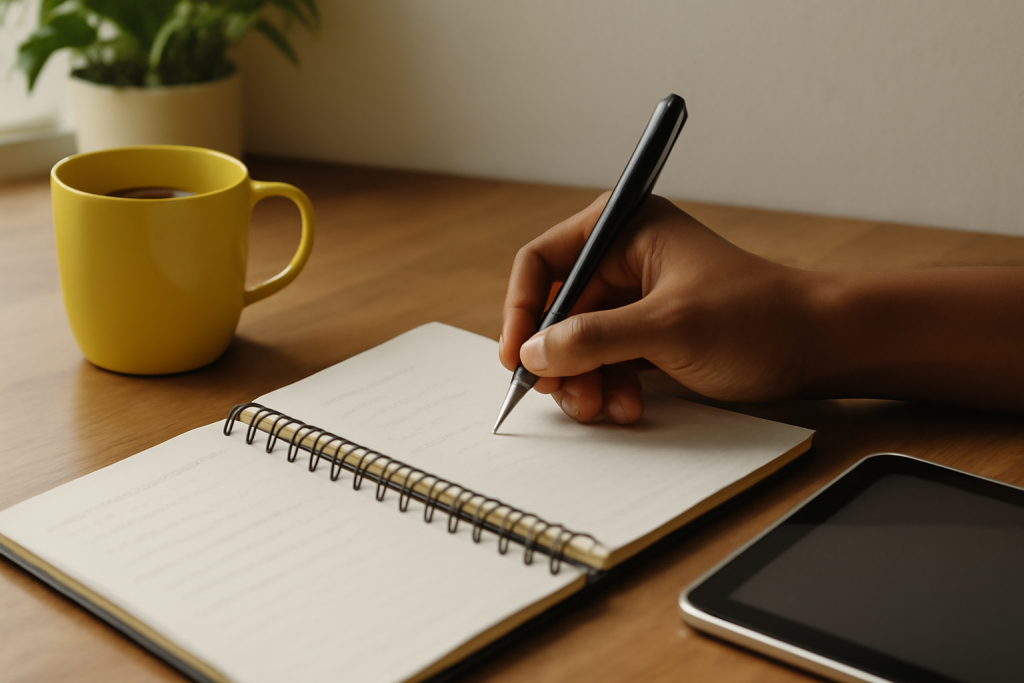We all experience moments of creative drought, where ideas seem to vanish into thin air. But did you know that many of the best ideas are hidden in the routine tasks of your daily life? Whether it’s during a morning walk, while making breakfast, or while responding to emails, inspiration can be just around the corner if you’re paying attention. This article explores how you can tap into these overlooked moments and turn your routine into a breeding ground for brilliant ideas.

The Hidden Power of Routine
Our daily routines often feel monotonous, with the repetitive nature of tasks numbing our minds. However, there’s a counterintuitive truth: the more structured our day is, the more likely it is that we can find opportunities for creative insights. Routine frees the mind by giving it less to worry about, which allows ideas to surface in the unlikeliest of moments.
The Science Behind Routine and Creativity
Research suggests that our brains often function at their most innovative when we’re in familiar, habitual settings. According to Dr. R. Keith Sawyer, a renowned expert in creativity, routine tasks allow the brain to switch to “default mode,” freeing cognitive resources that can then be redirected to solving problems or coming up with creative ideas (Sawyer, 2012). This is why many people experience creative bursts when performing menial tasks like washing dishes or taking a shower.
By finding a rhythm in your day, your brain is less likely to become distracted by the demands of your environment and can instead focus on more abstract, creative thoughts. So, even though your routine might seem unremarkable, it may actually be the perfect setting for generating new ideas.
Everyday Routines Where Ideas Hide
Now that we understand the scientific background behind creativity and routine, let’s dive into the common activities where ideas often hide. These activities, when viewed with a creative mindset, can unlock inspiration in unexpected places.
1. Morning Routines
The early hours of the day are when the mind is often at its most fresh. Whether it’s brewing coffee, exercising, or simply taking a few moments to reflect, the morning is a time when our brains are less cluttered by the distractions of the day. This state of mental clarity is a powerful tool for ideation. Some successful people, like Tim Ferriss, advocate for the importance of morning rituals, which include writing, journaling, or exercising, to set the tone for the rest of the day (Ferriss, 2017).
Action Tip: Try incorporating a few minutes of freewriting into your morning routine. The goal is not to write anything structured but to jot down whatever comes to mind. This can be an effective way to uncover ideas that might have otherwise remained hidden.
2. Commuting
The daily commute is another prime time when ideas can surface. While it’s easy to get lost in your thoughts or become frustrated by traffic, this time can actually be a creative goldmine. The sense of routine during your commute — the predictability of the route, the comfort of familiar surroundings — allows your mind to wander and generate creative insights.
Action Tip: Instead of focusing on the negatives of commuting, try to use this time for brainstorming or problem-solving. Bring a notebook or voice recorder to capture any ideas that come to you. Many entrepreneurs have credited their “commute time” as a critical part of their creative process.
3. Daily Tasks and Chores
Simple, repetitive tasks like washing dishes, folding laundry, or cleaning the house can provide the perfect environment for your mind to wander and think creatively. These tasks are usually automatic, so your brain has the space to process complex ideas and make connections that would otherwise go unnoticed.
Action Tip: Next time you do the dishes or take out the trash, focus on your surroundings and allow your mind to roam freely. Some of the most groundbreaking ideas have come from moments where people weren’t consciously trying to be creative at all.
4. Conversations and Emails
We often overlook the potential for creativity in everyday conversations. Whether it’s a casual chat with a colleague, a discussion with a friend, or an email thread with a family member, these interactions can spark new ideas. The key lies in being open to the input of others, as you may find that someone else’s perspective can lead to a breakthrough.
Action Tip: Actively engage in conversations where you’re not trying to “win” or lead the discussion but are simply listening and absorbing information. The ideas you gain from these moments can surprise you.
How to Foster Creativity in Your Routine
While your routine might already be an untapped source of creativity, there are several strategies to cultivate this habit and maximize your chances of having breakthrough moments.
1. Incorporate Downtime
One of the most important aspects of turning routine into a creative asset is giving yourself permission to have downtime. Downtime doesn’t mean doing nothing — it means engaging in tasks that are calming and repetitive, allowing your brain to switch off from more taxing mental activities. This gives your subconscious the room it needs to generate ideas without the pressure of a deadline.
Action Tip: Incorporate moments of downtime into your day where you simply focus on your breath or meditate, even if for just five minutes. This can be transformative for unlocking creativity.
2. Embrace Mindless Tasks
Sometimes, the best ideas come when you’re not forcing creativity to happen. Embrace tasks that don’t require much mental effort — like organizing your desk or watering plants. When you don’t have a problem to solve or a deadline looming over you, your mind is free to wander.
Action Tip: Use the time you spend on “mindless” tasks as a meditative space where you can let your thoughts flow. You may be surprised by what ideas emerge.
3. Stay Open to Inspiration
Inspiration rarely comes when we expect it, and it certainly doesn’t arrive when we demand it. Staying open to unexpected moments of creativity — even when you’re focused on a completely different task — is key. When you feel an idea bubbling up, write it down or record it quickly, as it might be gone before you realize it.
Action Tip: Keep a notebook or an app open on your phone to capture spontaneous ideas throughout the day. Your next great concept might be just a fleeting thought away.
Conclusion: The Power of Routine
The next time you feel like you’re in a creative rut, take a look at your routine. The solutions to many of your creative blockages might already be hidden within your daily activities. From your morning coffee to your commute, ideas can appear in the most mundane moments. By embracing the power of routine and allowing your mind the freedom to wander, you’re setting yourself up for creative breakthroughs in the most unexpected places.
References
- Ferriss, T. (2017) Tools of Titans: The Tactics, Routines, and Habits of Billionaires, Icons, and World-Class Performers. Available at: https://www.amazon.com (Accessed: 30 July 2025).
- Sawyer, R. K. (2012) Explaining Creativity: The Science of Human Innovation. Available at: https://global.oup.com (Accessed: 30 July 2025).
- Csikszentmihalyi, M. (1996) Flow: The Psychology of Optimal Experience. Available at: https://www.amazon.com (Accessed: 30 July 2025).









